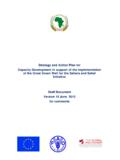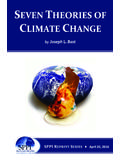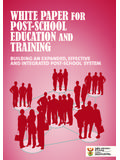Transcription of RESEARCH HIGHLIGHTS - AllerGen
1 ReAction Nov 2016. RESEARCH HIGHLIGHTS . Immunotherapy technique holds promise for curing food allergies AllerGen RESEARCH Leader Dr. John The pioneering treatment involves Gordon and his team at the University of exposing, in a test tube, a subject's Saskatchewan have developed a new dendritic cells to a mix of proteins, an acid immunotherapy technique that reverses naturally occurring in the human gut, and food allergies in mice. Their RESEARCH was an AllerGen ; and then reintroducing the co-funded by AllerGen and CIHR. modified cells back into the subject. The findings, published October 26, 2016, There is compelling evidence that the in the Journal of Allergy and Clinical technique could be effective in humans: Dr.
2 Immunology, will lead next to testing the Gordon's team has previously reversed an treatment on humanized mice. Pending asthmatic response in human cells in a test Health Canada approval, the first human tube, and effectively eliminated asthma in trial could begin in about a year, according afflicted mice. to Dr. Gordon. We predict the treatment could be on the market within five to 10 The technique also holds potential for years, he adds. treating autoimmune disorders like multiple sclerosis. It would take very little to adapt This discovery portends a major break- the therapy for autoimmune diseases, Dr.
3 Through towards a therapeutic reversal of Gordon notes. food AllerGen sensitivity, said AllerGen 's Scientific Director, Dr. Judah Denburg. Even if we only cure 25 percent of subjects, it would be life-changing for The treatment prevents anaphylactic affected individuals.. responses in what were previously fully sensitive mice, opening the door for Read the press release. translating this therapy into the clinic.. 1. Innovation from cell to society reAction Nov 2016. Recurrent anaphylaxis in kids: new C-CARE findings A new study by AllerGen researchers a higher degree of awareness of peanut suggests that nearly 18% of children who allergy among patients, and as such, are treated medically for an anaphylactic families are more diligent in avoiding reaction will experience another episode of peanut once an index episode has anaphylaxis within a year.
4 Occurred. As identified in other studies, milk was found to be a common trigger of The study also found that children with recurrent reactions, potentially because food-induced anaphylaxis and children with milk protein can appear in many products, asthma are at the greatest risk of which may not be labelled clearly, the experiencing recurrent reactions. authors noted. Published in The Journal of Pediatrics in The study also highlighted a significant October 2016, the study is the first to look underuse of epinephrine auto-injectors. We at the risk of anaphylaxis recurrence rates found that 80% of children experiencing a prospectively, once an initial, or index, recurrence of anaphylaxis were brought to episode has already occurred.
5 The emergency department, but 23% were Led by researchers from AllerGen 's Cross- not treated with epinephrine, comments Dr. Canada Anaphylaxis REgistry (C-CARE), Andrew O'Keefe, an allergist in St. John's, the study looked at the hospitalization Newfoundland, and the study's first author. records of 292 children who were treated It is critical that physicians, patients, and for anaphylaxis in three Montreal their families remain vigilant and under- Emergency Departments (ED) and by stand the importance of using epinephrine emergency medical services (EMS) in the immediately in all cases of anaphylaxis.
6 Outaouais region between 2011 and 2014. Funded by AllerGen , C-CARE was Food was the trigger for recurrent launched in 2010 and has since been episode(s) of anaphylaxis in nearly 85% of collecting data from thousands of adults the cases we looked at, says the study's and children treated for anaphylactic senior author, Dr. Moshe Ben-Shoshan, a reactions. Hospitals, ambulance para- pediatric allergist at the Montreal Children's medics, and allergy clinics in Quebec, Hospital and an assistant professor of British Columbia and Ontario contribute Pediatrics at McGill University.
7 Data to the registry, with expansion to other parts of the country underway. It is the first Interestingly, our results indicate that tree registry to track episodes of anaphylaxis nut was a trigger in of recurrent prospectively, at the time they occur. reactions, while peanut accounted for only We believe that it's possible there is 2. Innovation from cell to society reAction Nov 2016. AllerGen researchers find possible key to fibrosis in mouse model of Crohn's disease New RESEARCH by AllerGen investigators at Co-authors include AllerGen HQP Bernard The University of British Columbia (UBC) Lo and Dr.
8 Matthew Gold. has found that a group of immune cells known as Group 3 innate lymphoid cells The study is exciting because it has (ILC3) could be the key to the development uncovered the mechanism leading to of fibrosis in a mouse model of Crohn's fibrosis in a mouse model of Crohn's disease. disease, said Mr. Lo, a PhD candidate at UBC who was the paper's first author. The discovery may be applicable to fibrosis in other types of tissue, and could Since many patients developing fibrosis eventually lead to the development of a will require surgery, early intervention treatment for fibrotic complications of strategies are critical and ILC3 offers a Crohn's disease.
9 Promising therapeutic target.. Dr. Kelly McNagny, Associate Scientific Read the press releases: Director of the AllerGen Network, is lead AllerGen | UBC. author on the study, published on September 6, 2016 in Science Immunology. The cover image for the Science Immunology issue featuring this article was created by AllerGen HQP and co-author Bernard Lo. CLICK to view Dr. Kelly McNagny discussing the finding in a UBC video 3. Innovation from cell to society reAction Nov 2016. CIC researchers find new drug more effective than Xolair A new study by researchers in AllerGen 's alternative treatment to omalizumab with an Clinical Investigator Collaborative (CIC) has improved dosing frequency and potential shown that a developmental drug, QGE031 for greater efficacy against allergic (ligelizumab), is three times more effective responses in the airways and skin.
10 Than Xolair (omalizumab) in reducing The CIC researchers tested the drug in a symptoms of mild allergic asthma. group of 37 subjects with mild allergic The RESEARCH , led by Dr. Gail Gauvreau, the asthma and compared it to Xolair and CIC's Co-Director and a professor in the placebo in a parallel-group, double-blind, Department of Medicine at McMaster placebo-controlled trial. University, was conducted by CIC While antibody treatment is typically investigators at six Canadian universities reserved for severe asthma, this RESEARCH and one international site, and published in may lead to an improved therapy for those the October 2016 issue of the Journal of with allergic asthma that have issues with Allergy and Clinical Immunology.






